Bartholomew the Apostle
from wikipedia.org
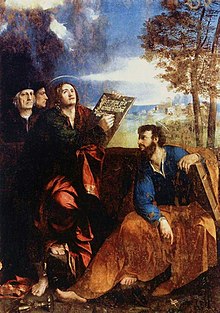 Bartholomew (Greek romanized: Bartholomaîos; Latin: Bartholomaeus; Hebrew romanized: bar-Tôlmay; Arabic romanized: Barthulmawus) was one of the twelve apostles of Jesus according to the New Testament. He has also been identified as Nathanael or Nathaniel, who appears in the Gospel of John when introduced to Jesus by Philip (who also became an apostle; John 1:43–51), although many modern commentators reject the identification of Nathanael with Bartholomew.
According to the Synaxarium of the Coptic Orthodox Church of Alexandria, Bartholomew's martyrdom is commemorated on the first day of the Coptic calendar (i.e., the first day of the month of Thout), which currently falls on September 11 (corresponding to August 29 in the Julian calendar). Eastern Christianity honours him on June 11 and the Catholic Church honours him on August 24. The Church of England and other Anglican churches also honour him on August 24.
The Armenian Apostolic Church honours Saint Bartholomew along with Saint Thaddeus as its patron saints. Bartholomew is English for Bar Talmai (ransliterated Bartholomaios in Greek) comes from the Aramaic: bar-Tolmay native to Hebrew "son of Talmai", or farmer, "son of the furrows" Bartholomew is listed among the Twelve Apostles of Jesus in the three synoptic gospels: Matthew,[10:1–4] Mark,[3:13–19] and Luke,[6:12–16] and also appears as one of the witnesses of the Ascension;[Acts 1:4, 12, 13] on each occasion, however, he is named in the company of Philip. He is not mentioned by the name "Bartholomew" in the Gospel of John, nor are there any early acta, the earliest being written by a pseudepigraphical writer, Pseudo-Abdias, who assumed the identity of Abdias of Babylon and to whom is attributed the Saint-Thierry (Reims, Bibl. mun., ms 142) and Pseudo-Abdias manuscripts.
In art Bartholomew is most commonly depicted with a beard and curly hair at the time of his martyrdom. According to legends he was skinned alive and beheaded so is often depicted holding his flayed skin or the curved flensing knife with which he was skinned.
New Testament references
Bartholomew (Greek romanized: Bartholomaîos; Latin: Bartholomaeus; Hebrew romanized: bar-Tôlmay; Arabic romanized: Barthulmawus) was one of the twelve apostles of Jesus according to the New Testament. He has also been identified as Nathanael or Nathaniel, who appears in the Gospel of John when introduced to Jesus by Philip (who also became an apostle; John 1:43–51), although many modern commentators reject the identification of Nathanael with Bartholomew.
According to the Synaxarium of the Coptic Orthodox Church of Alexandria, Bartholomew's martyrdom is commemorated on the first day of the Coptic calendar (i.e., the first day of the month of Thout), which currently falls on September 11 (corresponding to August 29 in the Julian calendar). Eastern Christianity honours him on June 11 and the Catholic Church honours him on August 24. The Church of England and other Anglican churches also honour him on August 24.
The Armenian Apostolic Church honours Saint Bartholomew along with Saint Thaddeus as its patron saints. Bartholomew is English for Bar Talmai (ransliterated Bartholomaios in Greek) comes from the Aramaic: bar-Tolmay native to Hebrew "son of Talmai", or farmer, "son of the furrows" Bartholomew is listed among the Twelve Apostles of Jesus in the three synoptic gospels: Matthew,[10:1–4] Mark,[3:13–19] and Luke,[6:12–16] and also appears as one of the witnesses of the Ascension;[Acts 1:4, 12, 13] on each occasion, however, he is named in the company of Philip. He is not mentioned by the name "Bartholomew" in the Gospel of John, nor are there any early acta, the earliest being written by a pseudepigraphical writer, Pseudo-Abdias, who assumed the identity of Abdias of Babylon and to whom is attributed the Saint-Thierry (Reims, Bibl. mun., ms 142) and Pseudo-Abdias manuscripts.
In art Bartholomew is most commonly depicted with a beard and curly hair at the time of his martyrdom. According to legends he was skinned alive and beheaded so is often depicted holding his flayed skin or the curved flensing knife with which he was skinned.
New Testament references
In the East, where Bartholomew's evangelical labours were expended, he was identified as "Nathanael", in works by Abdisho bar Berika (often known as "Ebedjesu" in the West), the 14th century Nestorian metropolitan of Soba, and Elias, the bishop of Damascus. Nathanael is mentioned only in the Gospel of John. In the Synoptic Gospels, Philip and Bartholomew are always mentioned together, while Nathanael is never mentioned. In John's gospel, however, Philip and Nathanael are similarly mentioned together. Giuseppe Simone Assemani specifically remarks, "the Chaldeans confound Bartholomew with Nathaniel". Some Biblical scholars reject this identification, however. Tradition
Eusebius of Caesarea's Ecclesiastical History (5:10) states that after the Ascension, Bartholomew went on a missionary tour to India, where he left behind a copy of the Gospel of Matthew. Other traditions record him as serving as a missionary in Ethiopia, Mesopotamia, Parthia, and Lycaonia. Popular traditions and legends say that Bartholomew preached the Gospel in India, then went to Greater Armenia. Mission to India Two ancient testimonies exist about the mission of Saint Bartholomew in India. These are of Eusebius of Caesarea (early 4th century) and of Saint Jerome (late 4th century). Both of these refer to this tradition while speaking of the reported visit of Pantaenus to India in the 2nd century. The studies of Fr A.C. Perumalil SJ and Moraes hold that the Bombay region on the Konkan coast, a region which may have been known as the ancient city Kalyan, was the field of Saint Bartholomew's missionary activities.Previously the consensus among scholars was against the apostolate of Saint Bartholomew the Apostle in India. Majority of the scholars are skeptical about the mission of Saint Bartholomew the Apostle in India . Stililingus ( 1703), Neande ( 1853), Hunter ( 1886), Rae ( 1892), Zaleski ( 1915) are the authors who supported the Apostolate of Saint Bartholomew in India. Scholars such as Sollerius ( 1669), Carpentier ( 1822), Harnack ( 1903), Medlycott ( 1905), Mingana ( 1926), Thurston ( 1933), Attwater ( 1935) etc does not support this hypothesis.The main argument is that the India, Eusebius and Jerome refers here should be Ethiopia or Arabia Felix. In Armenia
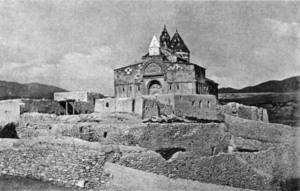 Along with his fellow apostle Jude "Thaddeus", Bartholomew is reputed to have brought Christianity to Armenia in the 1st century. Thus, both saints are considered the patron saints of the Armenian Apostolic Church.
One tradition has it that Apostle Bartholomew was executed in Albanopolis in Armenia. According to popular hagiography, the apostle was flayed alive and beheaded. According to other accounts he was crucified upside down (head downward) like St. Peter. He is said to have been martyred for having converted Polymius, the king of Armenia, to Christianity. Enraged by the monarch's conversion, and fearing a Roman backlash, King Polymius's brother, Prince Astyages, ordered Bartholomew's torture and execution, which Bartholomew endured. However, there are no records of any Armenian king of the Arsacid dynasty of Armenia with the name "Polymius". Current scholarship indicates that Bartholomew is more likely to have died in Kalyan in India, where there was an official named "Polymius".
The 13th-century Saint Bartholomew Monastery was a prominent Armenian monastery constructed at the site of the martyrdom of Apostle Bartholomew in Vaspurakan, Greater Armenia (now in southeastern Turkey).
Relics
Along with his fellow apostle Jude "Thaddeus", Bartholomew is reputed to have brought Christianity to Armenia in the 1st century. Thus, both saints are considered the patron saints of the Armenian Apostolic Church.
One tradition has it that Apostle Bartholomew was executed in Albanopolis in Armenia. According to popular hagiography, the apostle was flayed alive and beheaded. According to other accounts he was crucified upside down (head downward) like St. Peter. He is said to have been martyred for having converted Polymius, the king of Armenia, to Christianity. Enraged by the monarch's conversion, and fearing a Roman backlash, King Polymius's brother, Prince Astyages, ordered Bartholomew's torture and execution, which Bartholomew endured. However, there are no records of any Armenian king of the Arsacid dynasty of Armenia with the name "Polymius". Current scholarship indicates that Bartholomew is more likely to have died in Kalyan in India, where there was an official named "Polymius".
The 13th-century Saint Bartholomew Monastery was a prominent Armenian monastery constructed at the site of the martyrdom of Apostle Bartholomew in Vaspurakan, Greater Armenia (now in southeastern Turkey).
Relics
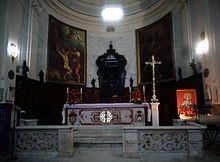 The 6th-century writer in Constantinople, Theodorus Lector, averred that in about 507, the Byzantine emperor Anastasius I Dicorus gave the body of Bartholomew to the city of Daras, in Mesopotamia, which he had recently refounded. The existence of relics at Lipari, a small island off the coast of Sicily, in the part of Italy controlled from Constantinople, was explained by Gregory of Tours by his body having miraculously washed up there: a large piece of his skin and many bones that were kept in the Cathedral of St Bartholomew the Apostle, Lipari, were translated to Benevento in 838, where they are still kept now in the Basilica San Bartolomeo. A portion of the relics was given in 983 by Otto II, Holy Roman Emperor, to Rome, where it is conserved at San Bartolomeo all'Isola, which was founded on the temple of Asclepius, an important Roman medical centre. This association with medicine in course of time caused Bartholomew's name to become associated with medicine and hospitals. Some of Bartholomew's alleged skull was transferred to the Frankfurt Cathedral, while an arm was venerated in Canterbury Cathedral.
Miracles
The 6th-century writer in Constantinople, Theodorus Lector, averred that in about 507, the Byzantine emperor Anastasius I Dicorus gave the body of Bartholomew to the city of Daras, in Mesopotamia, which he had recently refounded. The existence of relics at Lipari, a small island off the coast of Sicily, in the part of Italy controlled from Constantinople, was explained by Gregory of Tours by his body having miraculously washed up there: a large piece of his skin and many bones that were kept in the Cathedral of St Bartholomew the Apostle, Lipari, were translated to Benevento in 838, where they are still kept now in the Basilica San Bartolomeo. A portion of the relics was given in 983 by Otto II, Holy Roman Emperor, to Rome, where it is conserved at San Bartolomeo all'Isola, which was founded on the temple of Asclepius, an important Roman medical centre. This association with medicine in course of time caused Bartholomew's name to become associated with medicine and hospitals. Some of Bartholomew's alleged skull was transferred to the Frankfurt Cathedral, while an arm was venerated in Canterbury Cathedral.
Miracles
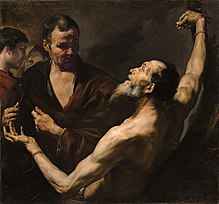 Of the many miracles claimed to have been performed by Bartholomew before and after his death, two very popular ones are known by the townsfolk of the small Italian island of Lipari.
The people of Lipari celebrated his feast day annually. The tradition of the people was to take the solid silver and gold statue from inside the Cathedral of St Bartholomew and carry it through the town. On one occasion, when taking the statue down the hill towards the town, it suddenly became very heavy and had to be set down. When the men carrying the statue regained their strength, they lifted it a second time. After another few seconds, it got even heavier. They set it down and attempted once more to pick it up. They managed to lift it but had to put it down one last time. Within seconds, walls further downhill collapsed. If the statue had been able to be lifted, all the townspeople would have been killed.
During World War II, the fascist regime looked for ways to finance their activities. The order was given to take the silver statue of Saint Bartholomew and melt it down. The statue was weighed, and it was found to be only a few grams. It was returned to its place in the Cathedral of Lipari. In reality, the statue is made from many kilograms of silver and it is considered a miracle that it was not melted down.
Saint Bartholomew is credited with many other miracles having to do with the weight of objects.
Art and literature
Of the many miracles claimed to have been performed by Bartholomew before and after his death, two very popular ones are known by the townsfolk of the small Italian island of Lipari.
The people of Lipari celebrated his feast day annually. The tradition of the people was to take the solid silver and gold statue from inside the Cathedral of St Bartholomew and carry it through the town. On one occasion, when taking the statue down the hill towards the town, it suddenly became very heavy and had to be set down. When the men carrying the statue regained their strength, they lifted it a second time. After another few seconds, it got even heavier. They set it down and attempted once more to pick it up. They managed to lift it but had to put it down one last time. Within seconds, walls further downhill collapsed. If the statue had been able to be lifted, all the townspeople would have been killed.
During World War II, the fascist regime looked for ways to finance their activities. The order was given to take the silver statue of Saint Bartholomew and melt it down. The statue was weighed, and it was found to be only a few grams. It was returned to its place in the Cathedral of Lipari. In reality, the statue is made from many kilograms of silver and it is considered a miracle that it was not melted down.
Saint Bartholomew is credited with many other miracles having to do with the weight of objects.
Art and literature
The appearance of the saint is described in detail in the Golden Legend: "His hair is black and crisped, his skin fair, his eyes wide, his nose even and straight, his beard thick and with few grey hairs; he is of medium stature..." Christian tradition has three stories about Bartholomew's death: "One speaks of his being kidnapped, beaten unconscious, and cast into the sea to drown. Another account states that he was crucified upside down, and another says that he was skinned alive and beheaded in Albac or Albanopolis", near Baskale, Turkey
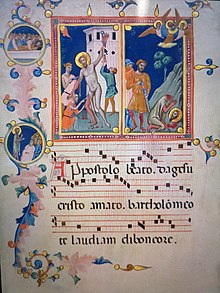 St Bartholomew is the most prominent flayed Christian martyr. During the 16th century, images of the flaying of Bartholomew were so popular that it came to signify the saint in works of art. Consequently, Saint Bartholomew is most often represented being skinned alive. Symbols associated with the saint include knives (alluding to the knife used to skin the saint alive) and his skin, which Bartholomew holds or drapes around his body. Similarly, the ancient herald of Bartholomew is known by "flaying knives with silver blades and gold handles, on a red field." As in Michelangelo’s Last Judgement, the saint is often depicted with both the knife and his skin. Representations of Bartholomew with a chained demon are common in Spanish painting.
Saint Bartholomew is often depicted in lavish medieval manuscripts. Manuscripts, which are literally made from flayed and manipulated skin, hold a strong visual and cognitive association with the saint during the medieval period and can also be seen as depicting book production. Florentine artist Pacino di Bonaguida, depicts his martyrdom in a complex and striking composition in his Laudario of Sant’Agnese, a book of Italian Hymns produced for the Compagnia di Sant’Agnese c. 1340. In the five scene, narrative based image three torturers flay Bartholomew's legs and arms as he is immobilised and chained to a gate. On the right, the saint wears his own flesh tied around his neck while he kneels in prayer before a rock, his severed head fallen to the ground. Another example includes the Flaying of St. Bartholomew in the Luttrell Psalter c.1325–1340. Bartholomew is depicted on a surgical table, surrounded by tormentors while he is flayed with golden knives.
St Bartholomew is the most prominent flayed Christian martyr. During the 16th century, images of the flaying of Bartholomew were so popular that it came to signify the saint in works of art. Consequently, Saint Bartholomew is most often represented being skinned alive. Symbols associated with the saint include knives (alluding to the knife used to skin the saint alive) and his skin, which Bartholomew holds or drapes around his body. Similarly, the ancient herald of Bartholomew is known by "flaying knives with silver blades and gold handles, on a red field." As in Michelangelo’s Last Judgement, the saint is often depicted with both the knife and his skin. Representations of Bartholomew with a chained demon are common in Spanish painting.
Saint Bartholomew is often depicted in lavish medieval manuscripts. Manuscripts, which are literally made from flayed and manipulated skin, hold a strong visual and cognitive association with the saint during the medieval period and can also be seen as depicting book production. Florentine artist Pacino di Bonaguida, depicts his martyrdom in a complex and striking composition in his Laudario of Sant’Agnese, a book of Italian Hymns produced for the Compagnia di Sant’Agnese c. 1340. In the five scene, narrative based image three torturers flay Bartholomew's legs and arms as he is immobilised and chained to a gate. On the right, the saint wears his own flesh tied around his neck while he kneels in prayer before a rock, his severed head fallen to the ground. Another example includes the Flaying of St. Bartholomew in the Luttrell Psalter c.1325–1340. Bartholomew is depicted on a surgical table, surrounded by tormentors while he is flayed with golden knives.
The festival in August has been a traditional occasion for markets and fairs, such as the Bartholomew Fair which was held in Smithfield, London, from the Middle Ages, and which served as the scene for Ben Jonson's 1614 homonymous comedy. St Bartholomew's Street Fair is held in Crewkerne, Somerset, annually at the start of September. The fair dates back to Saxon times and the major traders' market was recorded in the Domesday Book. St Bartholomew's Street Fair, Crewkerne is reputed to have been granted its charter in the time of Henry III (1207–1272). The earliest surviving court record was made in 1280, which can be found in the British Library. In Islam
The Qur’anic account of the disciples of Jesus does not include their names, numbers, or any detailed accounts of their lives. Muslim exegesis, however, more-or-less agrees with the New Testament list and says that the disciples included Peter, Philip, Thomas, Bartholomew, Matthew, Andrew, James, Jude, John and Simon the Zealot.